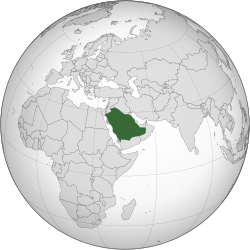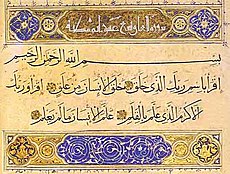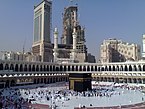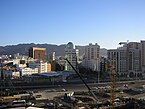Saudi Arabia
Kingdom of Saudi Arabia المملكة العربية السعودية al-Mamlaka al-‘Arabiyya as-Su‘ūdiyya | |
|---|---|
| Motto:لا إله إلا الله، محمد رسول الله "Lā ʾilāha ʾillāl–lāh, Muhammadun rasūl allāh" "There is no god but God; Muhammad is the messenger of God."[1][a](Shahada) | |
| Anthem:السلام الملكي(as an instrumental) "as-Salâm al-Malaki" "The Royal Salute" | |
 | |
| Capital and largest city | Riyadh |
| Official languages | Arabic |
| Demonym(s) | Saudi |
| Government | UnitaryIslamic absolute monarchy |
•King | Salman bin Abdulaziz Al Saud |
| Mohammad bin Salman | |
| Legislature | None- legislation by king's decree. |
| Establishment | |
| 23 September 1932[5] | |
| Area | |
• Total | 2,250,000 km2(870,000 sq mi) (12th) |
• Water (%) | 0.7 |
| Population | |
• 2024 estimate | 41,344,786[6](34th) |
• Density | 12/km2(31.1/sq mi) (216th) |
| GDP(PPP) | 2024 estimate |
• Total | $3.059 trillion[7] |
• Per capita | $24,056.715 |
| GDP(nominal) | 2024 estimate |
• Total | $2.094 trillion |
• Per capita | $19,890.183 |
| HDI(2011) | high·56th |
| Currency | Saudi riyal(SR) (SAR) |
| Time zone | UTC+3(AST) |
• Summer (DST) | UTC+3((not observed)) |
| Driving side | right |
| Calling code | +966 |
| ISO 3166 code | SA |
| Internet TLD | .sa,السعودية. |
Saudi Arabia,[b]officially known as theKingdom of Saudi Arabia (KSA),[c]is a country inWest Asiaincluding most of theArabian Peninsula.The land area is approximately 2,150,000 km2(830,000 sq mi), so Saudi Arabia is geographically the 5th-largest state inAsiaand 2nd-largest state in theArab worldafterAlgeria.Saudi Arabia is bordered byJordanandIraqto the north,Kuwaitto the northeast,Qatar,Bahrain,and theUnited Arab Emiratesto the east,Omanto the southeast, andYemento the south. It is separated fromPalestineandEgyptby The Red sea. It is the only nation with both aRed Seacoast and the Arabian Gulf coast, and most of its land is dry and barren. Saudi Arabia is the birthplace ofArabsandIslam[9]and sometimes called "the Land of the Two Holy Mosques" in reference toAl-Masjid al-Haram(inMecca), andAl-Masjid an-Nabawi(inMedina), the two holiest places in Islam.Arabicis the exclusiveofficial languagein Saudi Arabia.
Sunni Islamis thestate religion.[10]The practice of non-Islamic religions is not allowed in public but it's allowed in private.[11]TheHanbalischool of faith has a big influence, and the ultra-conservativeWahhabismreligious movement within Sunni Islam has been called "the predominant feature of Saudi culture".
Saudi Arabia is the largest state in westernAsiaby land area (most of theArabian Peninsula) and the second-largest in theArab World.It has an estimated population of 27 million, of which 8.8 million are registered foreign expatriates and an estimated 1.5 million areillegal immigrants.Saudi nationals comprise an estimated 16 million people.[12]
Saudi Arabia has the world's largestpetroleumreserves and is the world's largest oilexporter.[13]Oil accounts for more than 90% of exports and nearly 75% of government revenues, facilitating the creation of awelfare state.[14]However,human rightsgroups such asAmnesty InternationalandHuman Rights Watchhave expressed concern about the state ofhuman rights in Saudi Arabia.
Saudi Arabia has cities that are important to the Muslimreligion.Many Muslims from around the world visitMeccain Saudi Arabia to make apilgrimage.The pilgrimage is one of the "pillars of Islam". Other big cities areRiyadh,JeddahandDammam.The pilgrimage is calledhajjin theArabic language.Somebody who makes a pilgrimage to Mecca is called ahajjin the Arabic language. People who are not Muslim are not allowed to enter Mecca.
Most people speak theArabic language.
Thecurrencyof Saudi Arabia is referred to as theSaudi Riyal.[15]
History
[change|change source]The area of modern-day Saudi Arabia formerly consisted of four distinct regions:Hejaz,Najd, and parts of Eastern Arabia (Al-Ahsa) and Southern Arabia ('Asir). The Kingdom of Saudi Arabia was founded in 1932 by Ibn Saud. He united the four regions into a single state through a series of conquests beginning in 1902 with the capture of Riyadh, the ancestral home of his family, the House of Saud. The country has since been an absolute monarchy, governed along Islamic lines.
The Kingdom of Saudi Arabia was founded byAbdul-Aziz bin Saud(known for most of his career asIbn Saud) in 1932. The conquests which eventually led to the creation of the Kingdom began in 1902 when he capturedRiyadh,the ancestral home of his family, theHouse of Saud.The Saudi Arabian government, which is anabsolute monarchy,refers to its system of government as beingIslamic.It has a strong basis inWahhabism,a minority school of thought in Islam. The kingdom is sometimes called "The Land of the Two Holy Mosques" in reference toMasjid al-Haram(inMecca), andMasjid al-Nabawi(inMedina), the two holiest places inIslam.
Politics
[change|change source]
Saudi Arabia is anabsolute monarchy.[16]However, according to the Basic Law of Saudi Arabia adopted by royal decree in 1992, the king must comply withSharia(Islamic law) and theQuran,while the Quran and theSunnah(the traditions of Muhammad) are declared to be the country's constitution.[17]The primary source of law is the IslamicShariaderived from the teachings of theQur'anand theSunnah(the traditions of the Prophet).[18]Saudi Arabia is unique among modern Muslim states in that Sharia is notcodifiedand there is no system of judicial precedent, giving judges the power to use independent legal reasoning to make a decision. Saudi judges tend to follow the principles of theHanbalischool of jurisprudence (orfiqh) found in pre-modern texts[19]and noted for its literalist interpretation of the Qur'an andhadith.[20]
Because the judge is empowered to disregard previous judgments (either his own or of other judges) and may apply his personal interpretation of Sharia to any particular case, divergent judgements arise even in apparently identical cases,[21]making predictability of legal interpretation difficult.[22]The Sharia court system constitutes the basic judiciary of Saudi Arabia and its judges (qadi) and lawyers form part of the ulema, the country's Islamic scholars.
Royal decrees are the other main source of law; but are referred to asregulationsrather thanlawsbecause they are subordinate to the Sharia.[18]Royal decrees supplement Sharia in areas such as labor, commercial and corporate law. Additionally, traditional tribal law and custom remain significant.[23]Extra-Sharia government tribunals usually handle disputes relating to specific royal decrees.[24]Final appeal from both Sharia courts and government tribunals is to the King and all courts and tribunals follow Sharia rules of evidence and procedure.[25]
Culture
[change|change source]In Saudi Arabia, music and dance are important parts of life. People usually sing traditional songs together withpoetry.They play instruments like the rabābah, which is similar to a three-stringfiddle,andpercussion instrumentssuch as theṭabl(drum) and the ṭār (tambourine). The country's national dance isArdah,a sword dance from Najd. Men form lines or circles and sing poetry while performing it.[26]Bedouinpoetry, known as nabaṭī, is also well-liked.[27]
Since 1985, acultural heritagefestival namedJenadriyahis celebrated once every year, for two weeks.[27]
Women
[change|change source]
Ahijabis a traditional Islamic norm whereby women are required "to draw their outer garments around them (when they go out or are among men)" and dress in a modest manner.[28]Saudi Arabia is different from many Islamic societies in the extent of the covering that it considers Islamically correct hijab (everything except the hands and eyes) and the fact that covering is enforced byMutaweenor religious police.
Among unrelated men, women must cover the parts of the body that are awrah (private). In much of Islam, a women's face is not considered awrah. In Saudi Arabia and some other Arab states, all of the body is considered awrah except the hands and eyes. Accordingly, most women are expected to wear thehijab(head covering), a full black cloak called an abaya, and a face-veil calledniqab.Many historians and Islamic scholars argue that theQuranwas interpreted to require the veil as part of adapting it to tribal traditions.[29] [30][31][32]
Geography
[change|change source]
Saudi Arabia is home to the largest mass of sand on earth,[33]known as the Rub-al Khali desert (Rub-al Khali means "empty quarter" ). Thetemperatureis veryhot.There are almost no rivers or lakes in the country. There are manywadis.
The countries ofYemenandOmanaresouthof Saudi Arabia. Saudi Arabia iswestofQatar,theUnited Arab Emirates,Kuwait,Iraq,andJordan.All of these countries, except Jordan and Iraq, make theArabian Peninsula.
Animal life includeswolves,hyenas,mongooses,baboons,hares,sand rats,andjerboas.There used to be many larger animals such asgazelles,oryx,andleopards.By the 1950s hunting from motor vehicles made these animals almostextinct.Birds include falcons (which are caught and trained for hunting), eagles, hawks, vultures, sand grouse andbulbuls.There are several species of snakes, many of which are venomous, and numerous types of lizards. There is a wide variety of marine life in thePersian Gulf.Domesticated animals include camels, sheep, goats, donkeys, and chickens.
Because it is mostly a desert Saudi Arabia’s plant life is mostly small herbs and shrubs that need little water. There are a few small areas of grass and trees in southern Asir. Thedatepalm (Phoenix dactylifera) is widespread.
Provinces
[change|change source]Saudi Arabia is divided into 13provinces.[34]The provinces are divided into 118 governorates.
| No. | Region | Capital | |
|---|---|---|---|
 | |||
| 1 | Al Jawf (or Jouf) | Sakaka | |
| 2 | Northern Borders | Arar | |
| 3 | Tabuk | Tabuk | |
| 4 | Ha'il | Ha'il | |
| 5 | Al Madinah | Medina | |
| 6 | Al Qasim | Buraidah | |
| 7 | Makkah | Mecca | |
| 8 | Al Riyadh | Riyadh | |
| 9 | Eastern Province | Dammam | |
| 10 | Al Bahah (or Baha) | Al Bahah | |
| 11 | Asir | Abha | |
| 12 | Jizan | Jizan | |
| 13 | Najran | Najran |
Cities
[change|change source]These are the largestcitiesin Saudi Arabia.
| Largest cities by population (2007) |
mill. |

|

| |
|---|---|---|---|---|
| Riyadh | 8.7 | |||
| Jeddah | 4.6 | |||
| Mecca | 1.7 | |||
| Medina | 1.3 | Riyadh | Jeddah | Mecca |
| Dammam | 2.5 |  |
 |

|
| Ta'if | 0.7 | |||
| Buraydah | 0.6 | |||
| Tabuk | 0.5 | |||
| Abha | 0.4 | |||
| Khamis Mushait | 0.4 | Medina | Dammam | Abha |
Notes
[change|change source]- ↑Theshahada(statement of faith) is sometimes translated into English as "There is no god but Allah", using theromanizationof theArabicword "Allah"instead of its translation. The Arabic word"Allah"literally translates asthe God,as the prefix "Al-" is the definite article.[2][3][4]
- ↑Arabic:السعوديةas-Su‘ūdiyyaoras-Sa‘ūdiyya
- ↑Arabic:المملكة العربية السعوديةal-Mamlaka al-‘Arabiyya as-Su‘ūdiyya,
 Arabic pronunciation(help·info)
Arabic pronunciation(help·info)
References
[change|change source]- ↑"About Saudi Arabia: Facts and figures".The royal embassy of Saudi Arabia, Washington, D.C., United States. Archived fromthe originalon 2019-01-06.Retrieved2012-04-03.
- ↑"God".Islam: Empire of Faith.PBS.
- ↑"Islam and Christianity",Encyclopedia of Christianity(2001): Arabic-speaking Christians and Jews also refer to God asAllah.
- ↑L. Gardet. "Allah".Encyclopaedia of Islam Online.
- ↑"Saudi Arabia the country in Brief".Saudia-online. Archived fromthe originalon 2019-10-21.Retrieved2012-03-03.
- ↑Central Department Of Statistics & informationArchived2012-09-22 at theWayback Machineas updated 2010
- ↑"Saudi Arabia".International Monetary Fund.Retrieved31 March2012.
- ↑"HDRO (Human Development Report Office) United Nations Development Programme"(PDF).United Nations. 2011.Retrieved2 November2011.
- ↑"Cultural Dimension of Saudi Arabia".sauditourism.sauditourism. Archived fromthe originalon 11 November 2016.Retrieved11 November2016.
- ↑"The Basic Law of Government, Chapter one".
- ↑"International Religious Freedom Report 2010: Saudi Arabia".U.S. Department of State, Bureau of Democracy, Human Rights, and Labor. 2010.Retrieved2011-03-02.
- ↑"Saudi Arabia".American Bedu. Archived fromthe originalon 20 October 2011.Retrieved2 November2011.
- ↑Soldatkin, Vladimir; Nastassia Astrasheuskaya (November 9, 2011)."Saudi Arabia to overtake Russia as top oil producer-IEA".Reuters.Archived fromthe originalon 18 October 2015.Retrieved10 November2011.
- ↑"The Kingdom Of Saudi Arabia – A Welfare State".Royal Embassy of Saudi Arabia, London. Archived fromthe originalon 24 August 2011.Retrieved1 May2010.
- ↑Staff, Communicate."The Emerging Trends Shaping the Future of Brands in Saudi Arabia".communicateonline.me.Retrieved2021-02-22.
- ↑World and Its Peoples: the Arabian Peninsula.Marshall Cavendish. 2007. p. 78.ISBN978-0-7614-7571-2.
- ↑Robbers, Gerhard (2007).Encyclopedia of world constitutions, Volume 1.p. 791.ISBN978-0-8160-6078-8.
- ↑18.018.1Campbell, Christian (2007).Legal Aspects of Doing Business in the Middle East.Lulu. p. 265.ISBN978-1-4303-1914-6.
- ↑Hefner, Robert W. (2011).Shari'a Politics: Islamic Law and Society in the Modern World.Indiana University Press. p.58.ISBN978-0-253-22310-4.
- ↑Campo, Juan Eduardo (2006).Encyclopedia of Islam.Facts on File. p. 288.ISBN978-0-8160-5454-1.
- ↑Otto,pp. 161–162
- ↑Oxford Business Group (2009).The Report: Saudi Arabia 2009.Oxford Business Group. p. 202.ISBN978-1-902339-00-9.
it is not always possible to reach a conclusion on how a Saudi court or judicial committee would view a particular case [because] decisions of a court or a judicial committee have no binding authority with respect to another case, [and] in general there is also no system of court reporting in the Kingdom.
{{cite book}}:|author=has generic name (help) - ↑Otto,p. 157
- ↑Esposito, John L. (1998).Islam and politics.Syracuse University Press. pp.110–112.ISBN978-0-8156-2774-6.
- ↑Campbell, Christian (2007).Legal Aspects of Doing Business in the Middle East.Lulu. pp.268–269.ISBN978-1-4303-1914-6.
- ↑"Al-Ardha – The National Sword Dance of Saudi Arabia".Saudi Arabesque.2016-08-25.Retrieved2024-03-23.
- ↑27.027.1"Culture & Art | The Embassy of The Kingdom of Saudi Arabia".saudiembassy.net.Retrieved24 March2024.
- ↑"The Question of Hijab: Suppression Or Liberation?".islamswomen.Retrieved23 February2014.
- ↑"Niqab".BBC. 3 September 2009.Retrieved19 September2010.
- ↑Abdullah Atif Samih (7 March 2008)."Do women have to wear niqaab?".Islam Q&A.Archived fromthe originalon 23 September 2009.Retrieved2 June2008.
- ↑Munajjid (7 March 2008)."Shar'i description of hijab and niqaab".Islam Q&A. Archived fromthe originalon 16 July 2011.Retrieved2 June2008.
- ↑"Correct view on the ruling on covering the face".Archived fromthe originalon 18 February 2012.Retrieved19 September2010.
- ↑Vincent, Peter (2008).Saudi Arabia: an environmental overview.Taylor & Francis. p. 141.ISBN978-0-415-41387-9.Retrieved22 August2010.
- ↑"Saudi Arabia: Administrative divisions".arab.net.Retrieved2008-09-21.
Other websites
[change|change source]| Definitionsfrom Wiktionary | |
| Mediafrom Commons | |
| News storiesfrom Wikinews | |
| Quotationsfrom Wikiquote | |
| Source textsfrom Wikisource | |
| Textbooksfrom Wikibooks | |
| Learning resourcesfrom Wikiversity | |
- Saudi ArabiaArchived2016-11-20 at theWayback Machineofficial government website
- Saudi TV channels (live streams)
- Saudi Arabiaat theOpen Directory Project
- Saudi Arabia profilefrom theBBC News
- Saudi Arabia-Citizendium
- Wikimedia Atlas of Saudi Arabia



